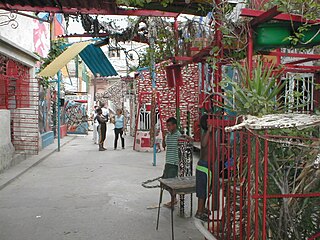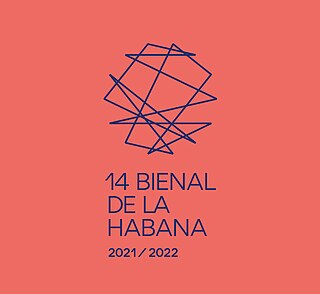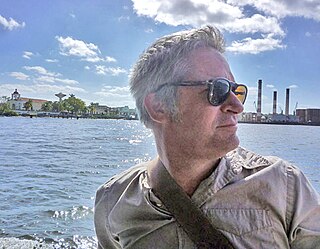Abel Herrero (born 1971) is a Cuban artist, known for painting, sculpture, photography, and installation art. He is based in Tuscany, Italy.
Abel Herrero (born 1971) is a Cuban artist, known for painting, sculpture, photography, and installation art. He is based in Tuscany, Italy.

Herrero was born in 1971 in Havana. In Cuba he began studying art and had his first solo exhibitions in Havana.
In 1994, he moved to Milan, where he furthered his artistic career and started to pursue his research and studies of iconography and symbolic representation in European art. He established relationships with protagonists of the artistic and intellectual scene which continue to influence his progressive formation. [1]
His artistic production ranges from paintings, sculptures and installations to photographies. Herrero's pictorical research moves in a borderline territory between figurative and not-figurative, where the chromatic element is elevated to being the conceptual content of the work. The production of his work takes place through fast gestural actions of subtraction of the pictorical material. [2] The result has been described as a powerful, essential painting, free from any form of pompous rhetoric, where also the time needed for its creation plays a determining role in the constructive logic of the same. [3]
He embraces Majakovsky’s thesis of economy in art as a fundamental aesthetic principle. During the last few years he has dedicated particular attention to the concept of Osservatorio [4] and the relationship between humans and their natural environment.
He has been living in the Tuscan countryside since 2010 [5] where he commenced his research on landscape connected to the concept of saturation. [6]
"That the image today is charged with the responsibility of reinforcing and conveying meaning of interpretation of the world and its values, places artists under the obligation to release it from this duty, saving it from the abyss of boredom and disenchantment".[ clarification needed ] Abel Herrero
In 2006 in Cuba he founded the project Guest Thinkers: meetings and discussions between the guests and the Cuban Institutions. Amongst those invited were Claudio Parmiggiani, Gianni Vattimo, Emanuele Severino, Bruno Corà, Jannis Kounellis.

Cuban art is an exceptionally diverse cultural blend of African, South American, European, and North American elements, reflecting the diverse demographic makeup of the island. Cuban artists embraced European modernism, and the early part of the 20th century saw a growth in Cuban avant-garde movements, which were characterized by the mixing of modern artistic genres. Some of the more celebrated 20th-century Cuban artists include Amelia Peláez (1896–1968), best known for a series of mural projects, and painter Wifredo Lam, who created a highly personal version of modern primitivism. The Cuban-born painter Federico Beltran Masses (1885–1949), was renowned as a colorist whose seductive portrayals of women sometimes made overt references to the tropical settings of his childhood.

Publio Amable Raúl Martínez González, known as Raúl Martínez, was a Cuban painter, designer, photographer, muralist, and graphic artist. He is best known for colorful pop-art portraits of leading Cuban political figures including José Martí and Camilo Cienfuegos.

José Ramón Villa Soberón is a Cuban artist, particularly known for his public sculptures around Havana. He studied at the Escuela Nacional de Arte in Havana, Cuba and the Academy of Plastic Arts in Prague. He is a professor at the Instituto Superior de Arte in Havana. His sculptures, paintings, engravings, drawings and designs are held by the Museo Nacional de Bellas Artes de La Habana, and in 1996 he was one of the selected artist in the second Trienal Americana de Escultura in Argentina.

Juan T. Vázquez Martín lived and worked in Havana, died in Miami. This artist is listed among the Cuban Painters masters. An exceptional prolific abstract painter with a refine style of paint, creativity and cultivated technique. Painter, founder and director of art schools and galleries, teacher of drawing and painting, he was an artist who travelled the world for solo exhibitions, or as a curator for Cuban painters art shows. His paintings are held in international and private collections in South and Central America and Caribbean islands, North America, Europe, Asia, Africa and Middle East.
Juan Francisco Elso, born Juan Francisco Elso Padilla in Havana, Cuba was a Cuban artist. He created art in a variety of media, such as drawing, painting, engraving, and sculpture, and also did installations. In 1972, he finished his studies in the Escuela Nacional de Bellas Artes “San Alejandro” in Havana. From 1972–1976, he studied in Escuela Nacional de Arte in Havana. He was also a teacher at 20 de Octubre School of Arts during the 1970s and 1980s.

José Braulio Bedia Valdés is a Cuban painter currently residing in Florida.
Adriano Buergo, is a Cuban artist specializing in painting, drawing and installations.
Raul Santoserpa is a Cuban artist specializing in painting and engraving.

Gladys Triana is a Cuban-American visual artist. Triana's career as an artist has spanned nearly six decades and includes works on paper, paintings, sculpture, mixed-media collage, installations, and photography. Triana currently resides in New York City and is still actively creating artwork.
José Toirac is a Cuban artist specializing in painting, drawing, and installation.

The Bienal de La Habana was an traditional Latin, Caribbean event, originated in Havana, Cuba, that aims to raise awareness to promote contemporary art and giving priority to Latin-American and Caribbean artists.
Yoan Capote is a Cuban sculptor who was born in 1977 in Pinar del Río. He received the UNESCO prize during the 7th Havana Biennial with the artists' collective DUPP.

José Manuel Fors is a contemporary Cuban artist born in Havana in 1956. His work is principally based on installations and supported by photography. His first artistic forays, during the early eighties, were part of what has been coined "The Renaissance of Cuban Art". His artwork has been shown in renowned museums and galleries in the United States, Europe and Cuba.

Felipe Dulzaides is a Cuban-born American contemporary artist. His practice includes installation, photography, video, drawing, sculpture and performance. Two important cities of reference of his works are San Francisco, California and Havana, Cuba.

Carlos Enrique Prado is a contemporary Cuban artist recognized for his contributions to the fields of ceramic sculpture and public art. Currently residing in Miami, Florida, Prado is actively engaged in both the creation of his art and the sharing of his expertise as a professor at the University of Miami in Coral Gables. His artistic endeavors span various mediums, including sculpture, ceramics, drawing, digital art, performance, installations, and interventions, showcasing versatility and creativity throughout his career. One of his notable recent achievements is the completion of the Ronald Reagan Equestrian Monument, a major public sculpture commissioned by Miami-Dade County and situated at the Tropical Park in Miami, Florida. In 2023, Carlos was selected as a member of the International Academy of Ceramics (AIC/IAC) based in Geneva, Switzerland. His affiliation with the AIC/IAC not only signifies his international recognition but also underscores his active engagement with the global ceramics community.
Alicia Leal Veloz is a Cuban painter. She was born in Sancti Spíritus, Cuba.

Jose Ramon Gonzalez Delgado is a contemporary Cuban artist, painter, engraver and ceramist.

Carlos Garaicoa is a Cuban contemporary artist, specializing in photography and installations. Garaicoa became a prominent Cuban artist in the nineteen-nineties after a massive exodus of artists who had played a decisive role in the Cuban art movement of the nineteen-eighties. His pieces often carry social and political commentaries about life in Havana. Garaicoa's work is known to draw on post-modernist theory to connect aesthetics to meaning within urban spaces and architecture.
Miguel A. Fleitas is a Cuban-American visual artist, photographer, and film director based in Miami, Florida. Fleitas was a television director and film editor for several popular television programs during his tenure with Univision and Telemundo. As an artist Fleitas has exhibited internationally, participated in high-profile exhibitions, and won awards since launching his art career in the 1980s. He is the son of Cuban filmmaker and artist Miguel Fleitas Sr.